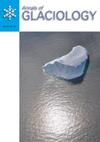利用分布式声学传感表征格陵兰出口冰川下的沉积物厚度:初步观察和高效机器学习方法的进展
IF 2.1
4区 地球科学
Q2 GEOGRAPHY, PHYSICAL
引用次数: 0
摘要
摘要分布式声学传感(DAS)越来越被认为是冰川地震应用的一种有价值的工具,尽管分析采集中产生的大量数据会带来计算挑战。我们展示了活动源DAS对快速流动的格陵兰出口冰川下的冰下沉积物进行成像和表征的潜力,估计沉积物层的厚度为20-30米。然而,缺乏冰下速度约束限制了这一估计的准确性。可以通过分析被动地震活动的3天对应记录中的低温地震事件来提供约束,例如通过地震层析成像,但将它们定位在9 TB的数据量内在计算上是低效的。我们描述了在训练卷积神经网络之前使用频率-波数(f-k)变换进行数据压缩的实验,该网络的效率提高了约300倍。通过将主动和被动源与我们的机器学习框架相结合,可以为未来的一系列应用释放大型DAS数据集的潜力。本文章由计算机程序翻译,如有差异,请以英文原文为准。
Characterising sediment thickness beneath a Greenlandic outlet glacier using distributed acoustic sensing: preliminary observations and progress towards an efficient machine learning approach
Abstract Distributed Acoustic Sensing (DAS) is increasingly recognised as a valuable tool for glaciological seismic applications, although analysing the large data volumes generated in acquisitions poses computational challenges. We show the potential of active-source DAS to image and characterise subglacial sediment beneath a fast-flowing Greenlandic outlet glacier, estimating the thickness of sediment layers to be 20–30 m. However, the lack of subglacial velocity constraint limits the accuracy of this estimate. Constraint could be provided by analysing cryoseismic events in a counterpart 3-day record of passive seismicity through, for example, seismic tomography, but locating them within the 9 TB data volume is computationally inefficient. We describe experiments with data compression using the frequency-wavenumber (f-k) transform ahead of training a convolutional neural network, that provides a ~300-fold improvement in efficiency. In combining active and passive-source and our machine learning framework, the potential of large DAS datasets could be unlocked for a range of future applications.
求助全文
通过发布文献求助,成功后即可免费获取论文全文。
去求助
来源期刊

Annals of Glaciology
GEOGRAPHY, PHYSICAL-GEOSCIENCES, MULTIDISCIPLINARY
CiteScore
8.20
自引率
0.00%
发文量
0
审稿时长
>12 weeks
期刊介绍:
Annals of Glaciology publishes original scientific articles and letters in selected aspects of glaciology-the study of ice. Each issue of the Annals is thematic, focussing on a specific subject. The Council of the International Glaciological Society welcomes proposals for thematic issues from the glaciological community. Once a theme is approved, the Council appoints an Associate Chief Editor and a team of Scientific Editors to handle the submission, peer review and publication of papers.
 求助内容:
求助内容: 应助结果提醒方式:
应助结果提醒方式:


